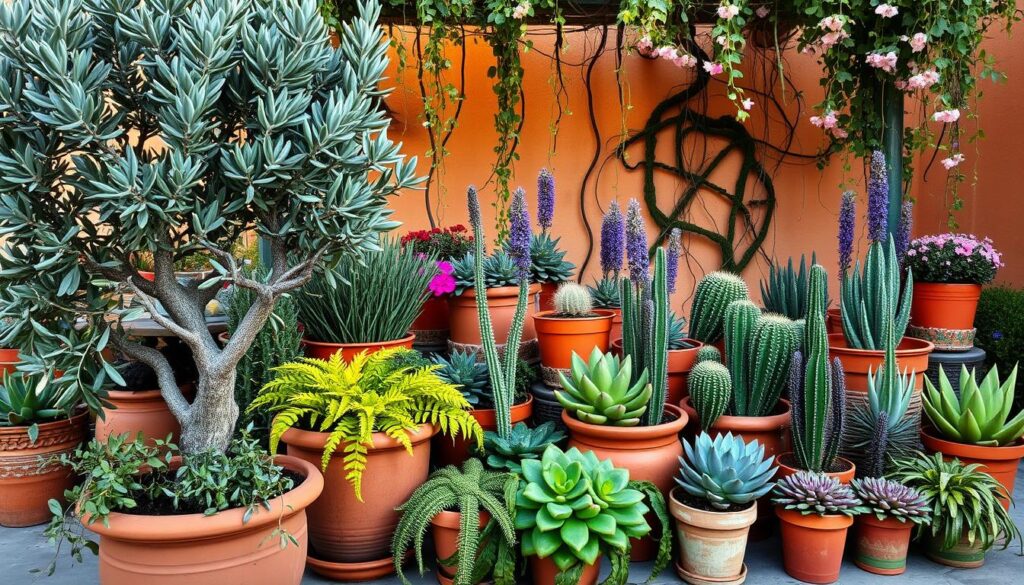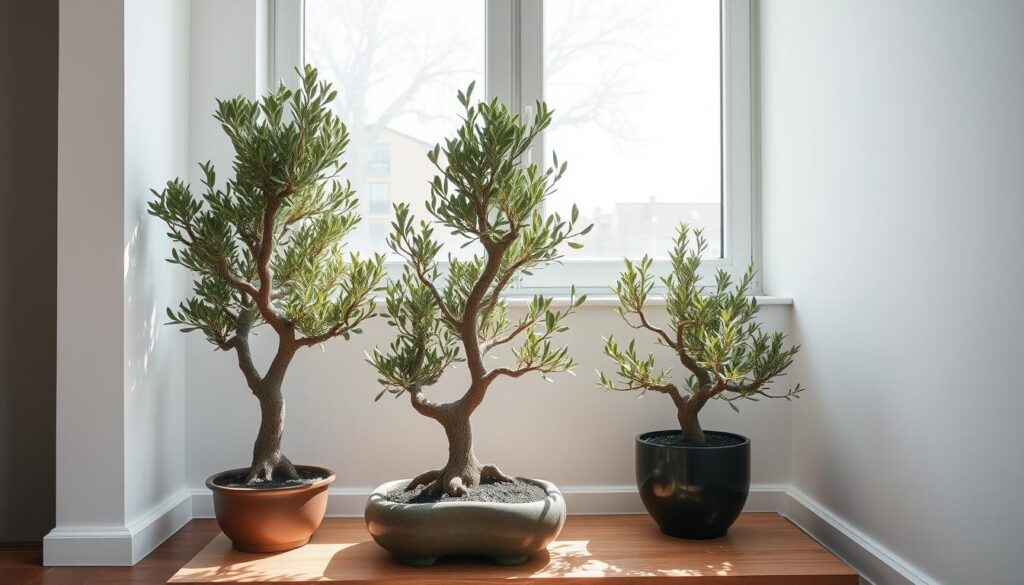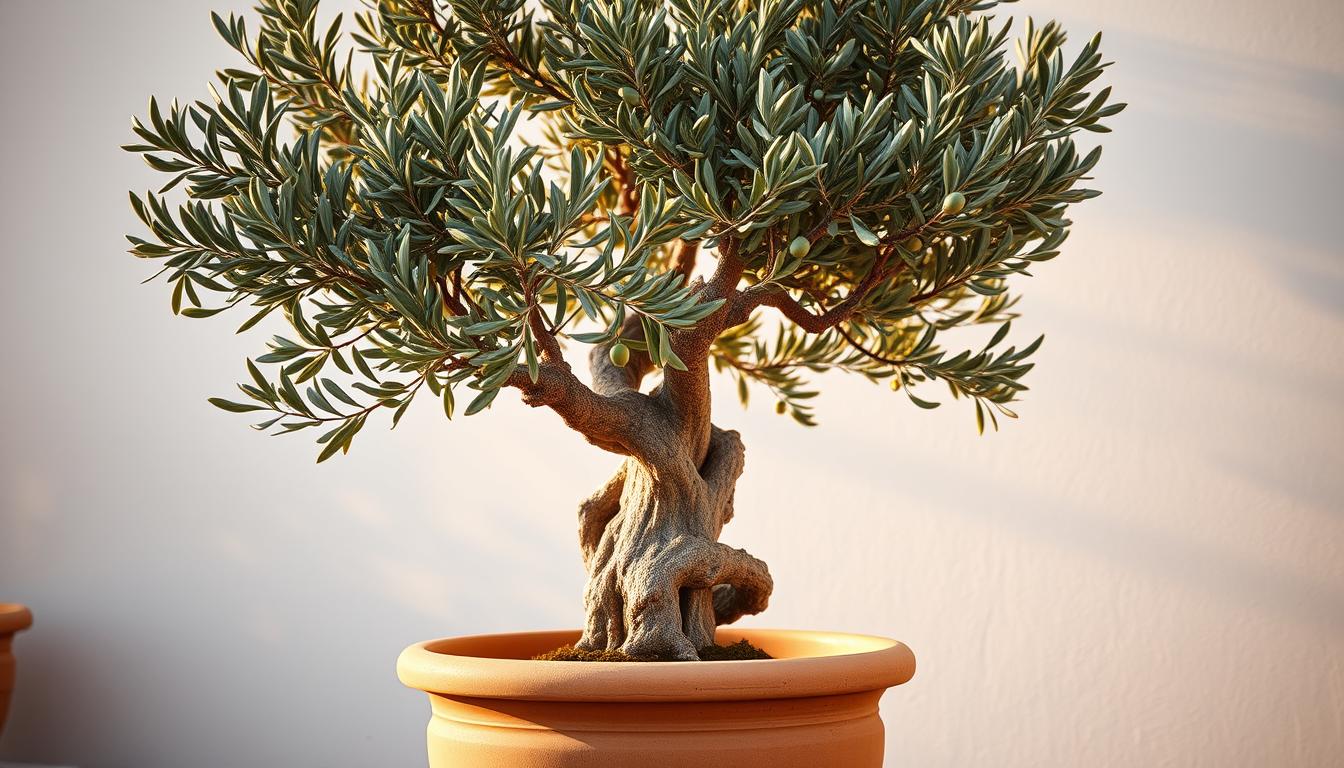Each home tells its own story—and sometimes, it all begins with a unique, meaningful plant. Imagine bringing the calm of Greece or Italy into your living room with a potted olive tree. These trees are more than plants; they add life and style to your space.
A potted olive tree adds instant drama to any room. Its silvery-green leaves and unique shape grab your attention. These plants add texture, elegance, and a sense of adventure to any area.
Whether you love design or want to add calm to your home, these trees are perfect. They fit in with modern or rustic styles, making any space better with ease.
Table of Contents
Understanding the Mediterranean Charm of Olive Trees
Mediterranean potted plants boast a timeless charm and a history rooted in tradition and elegance. Ornamental olive trees are symbols of cultural heritage. They go beyond decoration, showing a deep connection between plants and people.
Olive trees are more than plants. They stand for resilience, peace, and prosperity. Their roots connect ancient traditions with today’s design.
Origins and Cultural Significance
The olive tree’s history is long, starting in Greece, Italy, and Spain. These trees hold deep cultural meaning:
- Symbol of peace in ancient Greek mythology
- Representing wisdom and fertility
- Used in religious and diplomatic ceremonies
Characteristics of Mediterranean Olive Varieties
Mediterranean potted plants, like olive trees, have special traits:
- Exceptional drought resistance
- Ability to thrive in challenging environments
- Slow growth with elegant, sculptural forms
Adapting Mediterranean Style to Modern Spaces
Adding these timeless trees to modern design creates sophisticated, organic spaces. They fit well in both minimalist interiors and rustic outdoor areas. Ornamental olive trees bring Mediterranean elegance to any place.
Transform your living spaces with the enduring beauty of these remarkable botanical treasures.
Essential Guide to Potted Olive Tree Care
Growing a potted olive tree needs special care to keep it healthy and looking good. Container gardening olives requires attention to a few key things. These will help your tree do well in different places.
When picking a potted olive tree, remember these important care points:
- Sunlight exposure of 6-8 hours daily
- Well-draining soil mixture
- Consistent but moderate watering
- Protection from extreme temperatures
Choosing the right soil is crucial for container gardening olives. Use a Mediterranean plant potting mix that drains well. Your potted olive tree needs soil that doesn’t hold water but still gives enough nutrients.
Watering needs to be just right. Too much water can cause root rot, while too little can stress the plant. Check the soil by sticking your finger in about two inches deep. Water only when the top layer feels dry.
Pruning is key to keeping your potted olive tree in shape and healthy. Do some light pruning in early spring to remove dead branches and help it grow evenly. Use clean, sharp tools to avoid spreading disease.
In winter, move your potted olive tree to a safe place when it gets too cold. Wrap the container with something warm and water less during the tree’s sleep time.
Pro tip: Rotate your potted olive tree now and then. This helps the plant receive balanced sunlight exposure and promotes uniform growth.
Creating Stunning Entryway Statements
Your entryway sets the tone—it’s the first impression guests have of your home. A potted olive tree can turn this area into a stylish and welcoming space. These trees are not just plants; they become a centerpiece that shows off your taste in design.
When picking the right spot for your potted olive tree, think about a few things:
- Natural light availability
- Spatial flow and room dimensions
- Proximity to doors and walkways
- Overall room aesthetic
Choosing the Perfect Entry Location
The best spot for your potted olive tree is where it looks good and makes sense. Look for places with soft sunlight and enough room for the tree to grow. Corners near windows or next to entrance consoles are great for showing off these beautiful plants.
Pairing with Complementary Decor Elements
To make your olive tree look great, pair it with the right decor:
| Decor Element | Complementary Effect |
|---|---|
| Large Mirror | Amplifies natural light and creates depth |
| Ceramic Vase | Adds textural contrast |
| Neutral Bench | Provides functional seating |
Lighting Considerations for Entryway Display
Lighting can really make your potted olive tree stand out. Soft, ambient lighting makes the space feel cozy. Accent lights can also highlight the tree’s shape. Use wall sconces or floor lamps to make your entryway look amazing.
Indoor vs Outdoor Placement Strategies
Choosing the right spot for your olive trees is key to their health and look. Whether indoors or outdoors, knowing where to place them is vital for their growth.
Indoor olive trees need special care to do well. Look for a spot with lots of direct sunlight. South-facing windows are perfect for these Mediterranean plants. They need at least 6-8 hours of bright light each day.
- Choose rooms with consistent temperatures between 60-75°F
- Avoid cold drafts and sudden temperature changes
- Maintain humidity levels around 40-50%
Patio olive trees love the outdoors. They grow best in places that feel like their Mediterranean home. When placing them on a patio, keep these tips in mind:
- Select a spot with full sun exposure
- Protect from strong winds
- Ensure good air circulation
Pro tip: Many olive tree fans move their trees between indoors and outdoors with the seasons. This way, they get the best growing conditions all year.
Deciding between indoor and outdoor depends on your climate, space, and olive tree type. Some small varieties do great indoors, while others need the outdoors.
Selecting the Right Container for Your Olive Tree
Choosing the perfect container is key for growing olives in pots. The right container is important for your tree’s health and your space’s look. It can turn your olive tree into a beautiful design piece.
When picking containers for olive trees, think about a few important things. These ensure your tree grows well and looks great.
Material Matters: Exploring Container Options
There are different materials for olive tree containers:
- Terracotta: Classic and lets air in, but can dry out fast
- Ceramic: Looks good and comes in many styles
- Lightweight composite: Strong and easy to move
- Metal planters: Modern and sleek
Size and Drainage Essentials
Choosing the right size is crucial for growing olives in pots. Your container should:
- Be 2-3 times bigger than the root ball
- Have many drainage holes
- Give roots room to grow
“The right container is like a comfortable home for your olive tree – it must provide protection, breathability, and room to grow.” – Garden Design Expert
Aesthetic Considerations
Choose a container that fits your space’s style. A simple room might look good with a sleek white ceramic. A rustic patio could have a weathered terracotta pot.
Remember, your containers are more than just useful. They’re a statement that can make your whole space look better.
Balancing Visual Elements in Your Space

Designing with ornamental olive trees requires a balanced and harmonious approach. These Mediterranean potted plants can make your space stunning. They become focal points that boost your design.
To achieve visual harmony, consider these strategies:
- Contrast textures between your olive tree and surrounding elements
- Create depth by layering different heights and shapes
- Use complementary color palettes that highlight the tree’s natural beauty
When adding ornamental olive trees, think about their visual weight. Pair them with:
- Woven baskets that add natural texture
- Sleek side tables for modern contrast
- Minimalist artwork to create visual breathing room
Your Mediterranean potted plants should feel intentional, not accidental. Pay attention to proportion. A large olive tree needs space, while smaller ones fit in tight spots. Balance is about creating a dialogue between your plant and its environment.
Design is not just about placing objects, but creating a narrative that feels both intentional and effortless.
Remember, as your olive tree grows, you’ll need to reassess its placement. This keeps your design looking balanced.
Incorporating Texture and Natural Elements
Adding a potted olive tree to your space is more than just a simple move. It’s about making a room feel rich and full, celebrating the tree’s Mediterranean heritage.
When you style your mediterranean potted plants, think about textures. Your potted olive tree becomes a key piece that ties everything together. It makes your space feel welcoming and balanced.
Mixing Materials and Finishes
To add depth, mix different textures:
- Pair smooth ceramic planters with rough-textured woven baskets
- Combine sleek metal accents with natural wood surfaces
- Layer different fabric textures like linen, wool, and cotton
Creating Layered Designs
Layering is crucial for lively spaces with mediterranean potted plants. Place decorative items at different heights to catch the eye.
| Design Element | Height Level | Visual Impact |
|---|---|---|
| Potted Olive Tree | Medium-High | Focal Point |
| Low Ceramic Planters | Ground Level | Foundation |
| Hanging Macramé | High | Vertical Interest |
Adding Complementary Plants
Choose plants that bring out your potted olive tree’s beauty:
- Lavender – Shares Mediterranean origins
- Rosemary – Complements olive tree’s texture
- Succulents – Provide interesting contrast
By carefully blending textures and natural elements, you’ll craft a space that’s both elegant and earthy.
Seasonal Care and Maintenance Tips
Caring for a potted olive tree means watching out for seasonal changes. Your container gardening olives will do well with the right care all year round. This care should match each season’s needs.
Spring is a key time for your potted olive tree. It’s when you should prune and get your tree ready for growth. Remove dead or crossing branches to help your tree grow well.
- Prune in early spring before new growth emerges
- Check for winter damage and trim accordingly
- Apply a balanced fertilizer to support new growth
In summer, you need to protect your olive tree from the heat. Be sure to water it consistently and provide some shade during extreme heat. Olive trees prefer the soil to dry out slightly between waterings.
| Season | Key Maintenance Tasks | Watering Frequency |
|---|---|---|
| Spring | Pruning, Fertilizing | Moderate |
| Summer | Heat Protection, Pest Control | Regular Deep Watering |
| Fall | Reduced Fertilization | Decreased |
| Winter | Frost Protection | Minimal |
Autumn is important for your potted olive tree. Start to cut back on fertilizing and get your tree ready for cooler weather. Think about moving the tree to a safe spot if it gets really cold.
Winter care is all about keeping your olive tree safe from frost and cold. Move your container gardening olives inside or to a safe place. Water them less and don’t fertilize during this time when they’re not growing.
Design Ideas for Small Spaces and Apartments
Living in a small apartment doesn’t mean you have to miss out on having plants. Miniature olive trees are perfect for adding Mediterranean charm to tiny spaces.

To make your small space beautiful with dwarf olive trees, you need to plan and think creatively. These small plants can make even the smallest areas come alive.
Maximizing Limited Space
Here are some smart ways to use your small space:
- Choose miniature olive trees under 3 feet tall
- Utilize vertical space with wall-mounted planters
- Select narrow, columnar varieties of dwarf olive trees
- Use multi-functional furniture with integrated plant spaces
Creative Placement Solutions
Transform your apartment into a Mediterranean oasis with these clever tips:
- Position near windows for optimal natural light
- Create a mini indoor garden on a compact shelf
- Use plant stands to elevate your miniature olive trees
- Group smaller potted olive trees for visual impact
Scale Considerations for Compact Areas
Choosing the right size is key for olive trees in small spaces. Dwarf olive trees are usually between 18 inches and 4 feet tall. They’re perfect for apartments and small living areas.
Pro tip: Always measure your space and pick a tree that fits well without taking over the room.
Creating Mediterranean-Inspired Outdoor Living Areas
Turn your backyard into a peaceful Mediterranean oasis with patio olive trees. These plants can make any ordinary space feel like a sunny spot in Southern Europe.
Design your outdoor area with Mediterranean touches that match your olive trees:
- Create natural stone pathways around your patio olive trees
- Use terracotta pots for additional plantings
- Incorporate rustic seating areas near your olive tree clusters
- Add natural gravel surfaces to enhance the Mediterranean aesthetic
Think about the layout when placing your plants. Skylark olive trees look great along gravel paths. They add beauty and define areas for fun.
Here are some tips to make your outdoor space Mediterranean:
- Select containers that match the Mediterranean color palette
- Group olive trees to create natural shade zones
- Integrate herbs and lavender near your olive tree displays
- Use natural stone elements to complement the trees
With patio olive trees and the right design, your outdoor area can be a beautiful Mediterranean haven.
Styling Tips for Professional Looking Displays
Creating a professional display with ornamental olive trees needs careful planning and vision. Your styling can turn these plants into stunning focal points in any space.
Start by using the rule of thirds. Place your olive bonsai or potted olive tree a bit off-center. This creates visual interest and guides the eye across the space.
- Choose high-quality ceramic or terracotta containers that match your interior design
- Select containers with proper drainage to keep the tree healthy
- Consider neutral colors that let the olive tree’s natural beauty shine
Lighting is key in showcasing ornamental olive trees. Soft, indirect light creates dramatic shadows and highlights the tree’s texture. Place your olive tree near windows or use subtle accent lighting to enhance its form.
“A well-placed olive tree is like a living sculpture that breathes life into your space.” – Interior Design Expert
When styling, think about layering techniques. Combine your olive bonsai with smaller plants or ground covers. This adds depth and creates a sophisticated, professionally curated look.
- Trim your plants regularly to keep their shape and promote healthy growth.
- Rotate the plant periodically for even growth
- Clean leaves to keep a polished appearance
Remember, professional styling is about balance, restraint, and highlighting the natural beauty of your ornamental olive trees.
Conclusion
Potted olive trees add a special touch to your home with Mediterranean charm. They bring timeless beauty that goes beyond regular decor. They make your space look elegant and natural.
These plants fit well in any home, big or small. You can make them the main attraction in your decor. They work with many styles, from modern to traditional.
Having an olive tree brings a piece of Mediterranean culture into your home. They make your space look better and feel more peaceful. With the right care, your tree will grow and change with your home.
Starting a journey with potted olive trees means exploring design and beauty. Choose the right tree and learn how to care for it. Then, find the perfect spot for it. Your home will thank you for this Mediterranean touch.
FAQ
How long do potted olive trees live?
Potted olive trees can live 20-30 years with the right care. They need sunlight, water, and protection from extreme temperatures. This ensures they live a long life.
Can I grow an olive tree indoors year-round?
Yes, you can grow olive trees indoors. But they need specific conditions. Choose dwarf varieties like Arbequina and get 6-8 hours of sunlight daily.Keep temperatures between 60-80°F and ensure good air circulation. Sometimes, taking them outside in warm months helps them thrive.
How frequently should I water my olive tree in a pot?
Water your olive tree deeply but not too often. Check the soil’s moisture every 7-10 days in the growing season. In winter, water less often. Make sure the soil drains well to avoid root rot.
Do potted olive trees produce edible olives?
Some potted olive trees can produce fruit, but it’s not always tasty. For edible olives, pick varieties like Arbequina or Mission. Indoor trees might not produce as much fruit as outdoor ones.
What size container is best for an olive tree?
Start with a container 2-3 times larger than the root ball. Choose one that’s 16-24 inches in diameter. As it grows, move to bigger pots every 2-3 years.Use a potting mix made for Mediterranean plants and make sure it has drainage holes.
Can olive trees survive cold winters?
Most olive trees are hardy in USDA zones 8-11. For colder areas, pick cold-tolerant varieties like Arbequina. Bring potted trees indoors or protect them when it’s very cold.Use frost cloth or move them to a greenhouse if it gets too cold.
How do I prune my potted olive tree?
Prune your olive tree in late winter or early spring. Remove dead, crossing, or damaged branches. For indoor trees, cut back longer branches by about one-third to keep them compact.Always use clean, sharp tools for pruning.
What pests commonly affect olive trees?
Pests like scale insects, spider mites, and olive fruit flies can harm olive trees. Check your tree often and treat with neem oil or insecticidal soap. Keep your tree healthy to prevent pests.
How much sunlight do olive trees need?
Olive trees need full sun, at least 6-8 hours daily. Indoor trees should be near a south-facing window. If it’s not enough, use grow lights for growth and fruit production.
Can I create an olive tree bonsai?
Yes, olive trees are great for bonsai. Choose dwarf varieties and use well-draining soil. Regular pruning helps maintain the shape. Olive bonsai can be a beautiful addition to your space.

